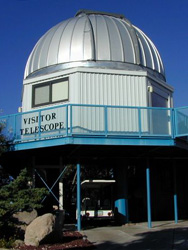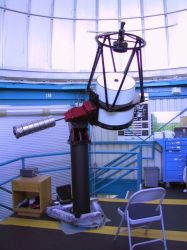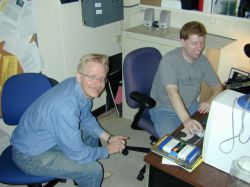 |
Kitt
Peak
Advanced Observing Program Image Processing |
 |
 |
Kitt
Peak
Advanced Observing Program Image Processing |
 |
![]()

![]()
Image ProcessingThe CCD images were captured with a ST10XME CCD camera by SBIG. For color imaging and guiding a filter wheel and the adaptive optics guiding unit AO7 are used.The telescope is pointed by TheSky software from Software Bisque. This also shows the projected size of the CCD on the sky and the position of the guide CCD. The exposure sequence is preprogrammed and the software also controls the filter wheel position. A little bug in the filter wheel requires to take a flush exposure between light images. The images are sent over the computer network to the image processing computer in the little office in the visitor center. Adam Block who runs the observing program uses
the solar equivalence processing technique for LRGB images. This technique
tries to balance the colors in the image similar to the white color of
day time solar light. The technique is described in detail by
With equal exposures in R, G and B filters the
following weight factor apply for exposures near the zenith:
During the same session dark frames and flat frames are also taken to guarantee the same conditions of telescope and CCD camera. 3 exposures are median averaged for the dark and the flat frames. Calibration for the light images is then done in Maxim DL by Diffraction Limited. After calibration a few hot pixel still show up in the image and are removed with a 'hot pixel kernel' filter. Blooming of bright stars introduces unsightly artifacts in the final images. They are removed at this stage using a deblooming plugin. The images are registered for accurate stacking. Sub pixel registering is done using Mira AP by Axiom Research. Stacking is again done in Maxim DL. The images are not directly averaged but rather first just summed up and then divided such that the maximum brightness in the target object just uses the maximum resolution of the 16bit FITS format. The final luminance image carries all the detail information for the color image. To bring out the details a Lucy-Richardson sharpening is used. CCDsharp by SBIG is used for this step. For registering of the luminance and R, G and B images Mira AP by Axiom Research is used again for sub pixel accuracy. The final LRGB combine is then done in Maxim DL by Diffraction Limited. Adjusting the darkest levels in the image histogram a neutral color of the sky background is achieved. Then the image is exported in 16Bit TIF format. Final adjustments and removal of cosmic ray artifacts is done in Adobe Photoshop. The image is then resized and stored. |
![]()
Back
to the results summary
Back
to the Kitt Peak page
October 2003, Sibylle Fröhlich
and Gert Gottschalk